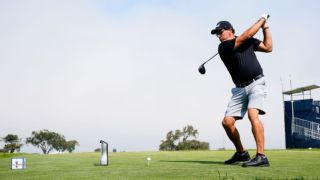|
SAN DIEGO -- There's nothing quite like playing in your hometown PGA Tour event, on a course you got to know as a kid, in front of family and friends, at a place where you've had success. It's even better when it's a major. The U.S. Open is on the South Course at Torrey Pines this week, a home game for Phil Mickelson, the reigning PGA Championship winner who turns 51 on Wednesday. In setting the record by becoming the oldest major champion in history last month, Mickelson also conjured up hopes and dreams that he could complete the career Grand Slam this week by winning that elusive U.S. Open title that he has come so agonizingly close to over the years. Having found the form and patience to win the PGA on a tough Kiawah Island course, why not at Torrey, a place with which he is seemingly familiar?  "It's not as much [of an advantage] as most people think,'' said Tim Mickelson, Phil's younger brother and caddie. That's the problem, the actual truth that will counter the narrative this week: that Phil Mickelson is returning home, to a place he loves, fresh off triumph, looking for the one missing piece of his Grand Slam puzzle. Because the reality is, Torrey Pines does not offer the type of home-course advantage Mickelson would prefer. This is not the same course he grew up on, not the same course on which he won three PGA Tour events. Honestly, this is not a course he really likes all that much anymore. And it is because of what was done to it to get the U.S. Open to come to his hometown. "We knew as kids that in our dream of having the U.S. Open coming to Torrey Pines, a redesign was going to be necessary,'' he said prior to the 2008 U.S. Open. "The course in its current state would never accommodate a championship of this magnitude. And to see that the golf course was done and renovated without any promise of a U.S. Open, but to see that it was completed in a way that could handle and tackle our national championship was exciting for everybody who put the time and effort in to try and achieve this dream.'' Mickelson always seethed over what Rees Jones did in the redesign. And he wasn't shy about expressing that opinion. "That new tee box is terrible,'' he said in 2008 about one added at the par-5 13th hole on the South Course. "It's the biggest waste of money that I've ever seen. But it doesn't matter what I think, we're going to end up playing it and I've got to be ready for it. But it's terrible.'' Known as the "Open Doctor,'' Jones is a well-regarded golf course architect who has been building and renovating courses for decades. He has routinely been brought in to redesign or toughen up numerous courses over the years in order to make them U.S. Open-worthy. He did the overhaul at Torrey Pines 20 years ago in hopes of the course getting consideration for a future U.S. Open. By the way, the last time Mickelson won at Torrey Pines? Yes, 20 years ago, in 2001, before the redesign. A year after the changes, the U.S. Open was awarded to Torrey, making it the second municipal course behind Bethpage Black to get such a prestigious tournament. That event, the 2008 U.S. Open won by Tiger Woods in a playoff over Rocco Mediate (when Woods played on a broken leg), proved so popular and the course so impressive that it was awarded this year's championship as well. "Phil knew all the breaks on the greens," Jones said in a recent phone call. "He just knew that course so well. He won the world junior [the Junior World Championship played annually at Torrey Pines]. He won the tour event there [three times]. [After the redesign], it was basically a new golf course to him. So I don't blame him for being angry, because it's not the same course. And he no longer has an advantage.'' But this isn't just about Torrey Pines. Mickelson's distaste for revamped Torrey Pines wasn't the only issue he has had with Jones' work. Other Jones redos have been the subject of his wrath. Mickelson wasn't thrilled with some of the changes made for the 2011 U.S. Open played at Congressional Country Club. He was annoyed with the revamped Atlanta Athletic Club when it hosted the 2011 PGA Championship. "It's a perfect example of how modern architecture is killing the game, because these holes are unplayable for the member," Mickelson said in 2011. "You have water in front and you have a bunker behind, and you give the player no avenue to run a shot up. ... "Now, for us out here, it doesn't make a bit of difference, because we are going to fly the ball to the green either way. And that's why I say it's great for the championship. But it's a good reason why the number of rounds are down on this golf course amongst the membership."  Mickelson was also critical of design changes made at Cog Hill outside of Chicago. That, too, came at Jones' hands as the course attempted to land the U.S. Open. That never happened, though it had the Western Open and the BMW Championship for several years. "The course changed pretty dramatically,'' said Jim "Bones'' Mackay, Mickelson's former caddie who now works for NBC. "In my experience caddying for some of these guys, so much of what they have that is important to them is mojo. Phil had that great mojo at Torrey Pines, winning [three] times prior to the redo. "The one thing about Phil is he's got this incredible memory. So one of the things he's going to lose after the redesign is all this knowledge about how the course plays and some real intricacies and nuances in terms of how he's going to go about approaching his business out there. So I feel he probably felt like he lost a bit of the mojo." Jones, 79, said he's never spoken to Mickelson about his issues but understands why he might be uncomfortable. "If you take a Bethpage and nobody has ever played it before and you redo it and make it U.S. Open-worthy, nobody ever knew the easier version,'' Jones said. "Then you take the easier version like they had at Torrey Pines, and some don't like the harder version. I think that is primarily what happened." Rees Jones, whose father, Robert Trent Jones Sr., and brother Robert Trent Jones Jr. are both well-known course architects, has designed or redesigned more than 150 courses. He has renovated 12 U.S. Open courses, including Torrey Pines, The Country Club in Brookline, Massachusetts (next year's venue), Baltusrol (where Mickelson won the 2005 PGA), Pinehurst No. 2 and Bethpage Black. The original architect for Torrey Pines, William P. Bell, was hired to design a course that was meant for mostly recreational play. It is difficult to envision him thinking when the course was first unveiled in 1957 that it would be the home for such a big tournament. "I can't get into his head, but he never utilized the natural aspects of the site in regards to the strategy of playing the course,'' Jones said. "He kept all the features away from the canyons. On the fourth hole, he didn't use the ocean side aspect of it. He didn't optimize the natural hazards that the site generally gave us. The green contours were simplistic. I think he was probably thinking that this is a course for the residents, it has a nice view, make it as easy as possible.'' Mickelson, who won his first PGA Tour event as an amateur at the 1991 Northern Telecom Open, won at Torrey Pines in 1993 for his first pro victory. He added wins in 2000 and 2001, holding off Woods by 4 strokes for that last one. Then the bulldozers came, and Mickelson has had only one really good chance to win here since. In 2011, he needed to hole out a wedge from 75 yards on the 72nd hole for eagle on the par-5 18th hole to force a playoff. Mickelson even had Mackay tend the pin. Of course, Phil narrowly missed. That was one of just four top-10s in 18 starts since the redesign. He's also missed three cuts in the past seven years, with a withdrawal. Adding to the angst, Mickelson missed out on a design project on the adjacent North Course, one he was extremely excited about doing. Mickelson talked often about how he would take more advantage of the scenery and make it an enjoyable experience for local players. He offered his services for free as a gift to his hometown. He lost the project due to a technicality: The California Fair Political Practices denied his bid because it said anyone who worked on preliminary designs could not take part in the design or the bid for construction based on the bid for the contract. Basically, Mickelson's enthusiasm for the project and preliminary work on it cost him. The job was later awarded to Tom Weiskopf. Perhaps the best advantage Mickelson has is recognizing his shortcomings on the course and trying to come to terms with them. After winning the PGA and then missing the cut the following week at the Charles Schwab Challenge, Mickelson has been home, able to use the week prior to the U.S. Open to practice at Torrey Pines. The course is closed to the public this close to the start of a major championship. "I'll try to spend some time out there to just get comfortable on the golf course,'' he said. "Honestly since the redo 20 years ago, I have not played that course as well as I would like. I tried to force it. A lot of pins you can't go to, have to play 60, 50 feet away, and a lot of holes I get overly aggressive; obviously, that's my nature. "There's a proper way to play it, and I've seen it and I want to have the discipline to do it, so I want to spend some time out there and develop a good game plan.'' That is the real lesson here. Mickelson has never really figured out his hometown course since it was altered 20 years ago. Whether he can finally embrace it will be part of his quest this week.
|
